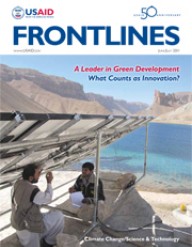 A young girl tests out a new seesaw on a playground built by the Elizabeth Glaser Pediatric AIDS Foundation at the Mkhulamini Clinic in Swaziland.
Jon Hrusa, Elizabeth Glaser Pediatric AIDS Foundation
A young girl tests out a new seesaw on a playground built by the Elizabeth Glaser Pediatric AIDS Foundation at the Mkhulamini Clinic in Swaziland.
Jon Hrusa, Elizabeth Glaser Pediatric AIDS Foundation
 A young girl tests out a new seesaw on a playground built by the Elizabeth Glaser Pediatric AIDS Foundation at the Mkhulamini Clinic in Swaziland.
Jon Hrusa, Elizabeth Glaser Pediatric AIDS Foundation
A young girl tests out a new seesaw on a playground built by the Elizabeth Glaser Pediatric AIDS Foundation at the Mkhulamini Clinic in Swaziland.
Jon Hrusa, Elizabeth Glaser Pediatric AIDS Foundation
In Africa today, USAID is focused on ending malaria, preventing HIV/AIDS transmission, and curbing other infectious disease like tuberculosis, avian influenza, and neglected tropical diseases. But, over the next decade, non-communicable diseases (NCDs) like obesity, diabetes, and cardiovascular diseases—with common risk factors such as tobacco use, alcohol abuse, and over consumption of fat-rich diets—will be the next major health challenges facing the continent, said African ministers of health at a meeting in Brazzaville, Congo, this past April. What was their rallying cry? “Unite against NCDs, the time to act is now.”
Other evidence suggests that Africa is midway through a demographic shift from high to low death rates—and birth rates—despite a decade or more of the devastating consequences of HIV/AIDS and other deadly diseases.
The emerging African middle class continues to grow, and over the next 20 years, according to experts, it will exceed those of India and China. This growth, combined with rapid urbanization, likely will force other changes over the next decade or sooner. In less than 15 years, the majority of Africans will live in cities and towns, not in rural areas, demographers say.
What does this mean for those working to help African societies and economies develop? To stay ahead of the curve, development assistance needs to stay up on the latest trends so that strategies are not fixed in the past and programs are targeted for new challenges just over the horizon.
To do this right, the Agency must take a more systematic approach, and there is one tool designed to do just that—future trends analysis. This is already going on in some parts of the Agency like the Bureau for Global Health and the Office of Conflict Management and Mitigation, but those are more the exceptions than the rule.
An Age of Cyclonic Change
When it comes to rapidly changing landscapes, Africa is by no means unique; fast-paced development trends are occurring in Asia and Latin America as well. Dynamic trends are also emerging across sectors, not just geographic regions. Global transitions in basic education are underway with a growing shift away from classroom-centered and teacher-driven learning experiences to more online and interactive student-to-student and student-to-teacher exchanges.
In high schools here and abroad, students with computers and Internet access are using real-time “backchannel” digital streams, allowing them to participate in classroom discussions without ever having to raise their voices. Increased institutional networking among academic institutions and open networking will soon allow future students anywhere in the world to choose their own courses—maybe even design their own curricula.
Looking ahead to the near future, many development professionals are asking what today’s smart phones and e-readers will look like in a decade, will they even exist, and how will Agency strategies and programs in education, micro-finance, governance, and health be positioned to stay ahead of the development curve. Will partner country medical diagnostics be done at home, in local clinics, or “in the cloud”? Could the death and destruction caused by natural disasters be mostly avoidable through new technologies, tools, and advanced personalized communications? And, will the power of social media, so much in the headlines today, wither, or will it actually become a major driver of a powerful new kind of citizen governance?
“The Present Depends on the Future”
Today’s development challenges are more complex, involve more players, are more interactive, more networked, more interdisciplinary, and more global than ever before. If that was not enough, these challenges are moving at cyclonic rates compared to previous decades.
Alex Dehgan, science adviser to USAID’s administrator, framed the question of tackling impeding change this way: “If development is to make a lasting difference, USAID must marshal everything it and other institutions know about future trends to influence current development policies and strategies—and design and implement programs accordingly.”
That means that looking at development trends in population, migration, urbanization, food scarcity, and natural resource capacity, for example, is no longer a luxury exercise.
The disciplined analysis of identifying emerging development trends and examining their underlying causes goes by many names, but is more widely known today as foresight research.
With foresight research there is no illusion about predicting events five and 10 years out—let alone 20 years. At the same time, through serious trend analysis, organizations like USAID can reasonably identify signposts that suggest a certain direction seems highly likely or not. Even when the future is unknown, it is possible to engage in what is called “scenario planning,” similar to what the military calls “war gaming.” Known facts about the future, such as the youth bulge that demographers have been warning about for years, and the steady rise in urbanization that geographers and others have carefully documented, are combined with plausible alternatives, such as the need for rapid job creation and responding swiftly to megacity demands.
While any one scenario is unlikely, this exercise helps policy-makers anticipate new approaches and re-examine past assumptions. A few years back, USAID was among the pioneers in just this sort of scenario planning in an interagency-led program called Project Horizon, which brought together senior executives from the National Security Council and global affairs agencies to conduct whole-of-government strategic planning to confront a range of changing realities.
Understanding long- and longer-term trends can dramatically improve the probability that development programs will have their desired impacts now, in the short run, and hopefully over time. That’s why USAID has been actively exploring foresight planning and examining options to increase its internal capacity to make it happen.
The age-old adage that the “future depends on the past” has been up-ended in today’s development environment to read that “the present depends on the future.” Dehgan summed up the big challenge before the Agency this way: “As a premier development enterprise, we must open ourselves up to the possibility that the future could be very different from what we imagine today, and then we must act now on what we know.”









Comment
Make a general inquiry or suggest an improvement.